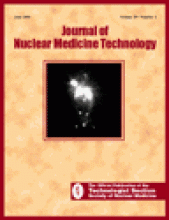W.C. Klingensmith III, D. Eshima, and J. Goddard. Englewood, Colorado: Wick Publishing, Inc.; 2000; $245.00, hardcover; $225.00, disk.
The authors set the tone and scope of this procedure manual on the very first page—it is designed primarily for physicians qualified to practice in the area of nuclear medicine. The manual can serve as an intact departmental procedure manual, or, more likely, as a starting point for the nuclear medicine physician to review and modify specific procedures while incorporating “local preferences and needs”. Physicians and technologists alike will find this procedure manual a well-documented and comprehensive resource for their departments.
The manual is nicely structured and contains 60 separate clinical procedure sheets, along with information on 40 different radiopharmaceuticals. The authors have made the pages of this manual easy to remove (and move around), and have also reinforced the 3-ring punch margins so that the pages will withstand heavy use. The ring binder, which contains the manual, has also been enlarged with this edition so that department-specific procedures may be added as desired. The manual is divided into 5 major sections: general policies, diagnostic procedures, therapeutic procedures, radiopharmacy and appendices.
The general policies section contains a wealth of information, and provides an overview of the familiar, but nonetheless important, procedures to be considered prior to beginning and during a nuclear medicine study (injection techniques, patient care, dosing guidelines, general positioning concepts). The general policies section also features a fairly large segment on departmental guidelines, which contains an excellent section on radiation safety and information on procedure scheduling.
The largest segment of the manual, the diagnostic procedures portion, is divided into 10 anatomic or organ-system sections (e.g., cardiovascular, endocrine, genitourinary systems), plus a section on tumor imaging. Each section contains an average of 5 procedures, with several procedures comprising multiple methods or multiple radiopharmaceutical options. The procedure pages are laid out using a standardized approach that makes them easy to read, logically formatted, and consistent. Each procedure discussed follows this general format: overview, clinical indications, examination time, patient preparation, equipment, radiopharmaceutical, dose and technique, patient positioning/imaging information, acquisition protocol, data processing, optional maneuvers, radiation information (emission data and dosimetry), and lastly (and perhaps most importantly), a list of references. The section on bone mineral studies is somewhat confusing, in that it pertains to the traditional 99mTc MDP/HMDP bone scan and not a bone mineral density (dexa or other absorptiometry) study. Each of the segments is well-referenced with a number of library resources, which makes it easy to find more information concerning patient preparation, imaging information, clinical indications, or other topics if needed.
The therapeutic section, the smallest in the manual, contains suggested procedures for treating diseases of the endocrine, hematologic and skeletal systems. The final portion of the manual is a comprehensive section devoted to the radiopharmaceuticals used in nuclear medicine practice. Each of the 40 radiopharmaceuticals is presented (including 19 99mTc radiopharmaceuticals) in a standardized, segmented format—clinical uses, general information, radiation emission, commercial sources, radiochemical information and references.
The authors provide a user’s guide that describes the changes made since previous editions, listing which procedures were added or deleted, and why. Added since the 1997 edition are procedures using 111In-Imicromab pentate (Myoscint) for myocardial infarct imaging, 99mTc apcitide for acute venous thrombosis imaging, 18F fluorodeoxyglucose for myocardial viability, 14C urea for detecting Helicobacter pylori, and 153Sm for the treatment of bony metastases. Some of the studies that the authors removed from the procedure manual may still be performed in your particular clinical setting. For example, the testicular imaging procedure was deleted from the 1997 edition, but is still in use locally. The manual, although intended for physicians, is appropriate for use by all nuclear medicine professionals. It is a well-organized, wonderfully referenced resource that can serve as the basis for the development of your own specific procedure manual.







